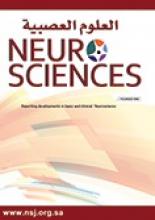Research ArticleOriginal Article
Open Access
Prevalence and associated factors of alexithymia among medical students: A cross-sectional study from Saudi Arabia
Mohammed A. Aljaffer, Ahmad H. Almadani, Saleh A. Alghamdi, Ibrahim M. Alabdulkarim, Mohammed A. Albabtain, Rayed M. Altameem, Abdulrahman A. Almugren, Abdulaziz F. Alomairy and Abdulaziz A. Alghofaily
Neurosciences Journal October 2022, 27 (4) 257-262; DOI: https://doi.org/10.17712/nsj.2022.4.20220049
Mohammed A. Aljaffer
From the Department of Psychiatry (Aljaffer, Almadani), College of Medicine, King Saud University, from the College of Medicine (Alabdulkarim, Albabtain, Altameem, Almugren, Alomairy, Alghofaily), King Saud University, and from the Clinical Neurosciences Department (Alghamdi), College of Medicine, Imam Mohammad Ibn Saud Islamic University, Riyadh, Kingdom of Saudi Arabia
MBBS, MDAhmad H. Almadani
From the Department of Psychiatry (Aljaffer, Almadani), College of Medicine, King Saud University, from the College of Medicine (Alabdulkarim, Albabtain, Altameem, Almugren, Alomairy, Alghofaily), King Saud University, and from the Clinical Neurosciences Department (Alghamdi), College of Medicine, Imam Mohammad Ibn Saud Islamic University, Riyadh, Kingdom of Saudi Arabia
MBBS, FRCPCSaleh A. Alghamdi
From the Department of Psychiatry (Aljaffer, Almadani), College of Medicine, King Saud University, from the College of Medicine (Alabdulkarim, Albabtain, Altameem, Almugren, Alomairy, Alghofaily), King Saud University, and from the Clinical Neurosciences Department (Alghamdi), College of Medicine, Imam Mohammad Ibn Saud Islamic University, Riyadh, Kingdom of Saudi Arabia
MBBS, MDIbrahim M. Alabdulkarim
From the Department of Psychiatry (Aljaffer, Almadani), College of Medicine, King Saud University, from the College of Medicine (Alabdulkarim, Albabtain, Altameem, Almugren, Alomairy, Alghofaily), King Saud University, and from the Clinical Neurosciences Department (Alghamdi), College of Medicine, Imam Mohammad Ibn Saud Islamic University, Riyadh, Kingdom of Saudi Arabia
MBBSMohammed A. Albabtain
From the Department of Psychiatry (Aljaffer, Almadani), College of Medicine, King Saud University, from the College of Medicine (Alabdulkarim, Albabtain, Altameem, Almugren, Alomairy, Alghofaily), King Saud University, and from the Clinical Neurosciences Department (Alghamdi), College of Medicine, Imam Mohammad Ibn Saud Islamic University, Riyadh, Kingdom of Saudi Arabia
MBBSRayed M. Altameem
From the Department of Psychiatry (Aljaffer, Almadani), College of Medicine, King Saud University, from the College of Medicine (Alabdulkarim, Albabtain, Altameem, Almugren, Alomairy, Alghofaily), King Saud University, and from the Clinical Neurosciences Department (Alghamdi), College of Medicine, Imam Mohammad Ibn Saud Islamic University, Riyadh, Kingdom of Saudi Arabia
MBBSAbdulrahman A. Almugren
From the Department of Psychiatry (Aljaffer, Almadani), College of Medicine, King Saud University, from the College of Medicine (Alabdulkarim, Albabtain, Altameem, Almugren, Alomairy, Alghofaily), King Saud University, and from the Clinical Neurosciences Department (Alghamdi), College of Medicine, Imam Mohammad Ibn Saud Islamic University, Riyadh, Kingdom of Saudi Arabia
MBBSAbdulaziz F. Alomairy
From the Department of Psychiatry (Aljaffer, Almadani), College of Medicine, King Saud University, from the College of Medicine (Alabdulkarim, Albabtain, Altameem, Almugren, Alomairy, Alghofaily), King Saud University, and from the Clinical Neurosciences Department (Alghamdi), College of Medicine, Imam Mohammad Ibn Saud Islamic University, Riyadh, Kingdom of Saudi Arabia
MBBSAbdulaziz A. Alghofaily
From the Department of Psychiatry (Aljaffer, Almadani), College of Medicine, King Saud University, from the College of Medicine (Alabdulkarim, Albabtain, Altameem, Almugren, Alomairy, Alghofaily), King Saud University, and from the Clinical Neurosciences Department (Alghamdi), College of Medicine, Imam Mohammad Ibn Saud Islamic University, Riyadh, Kingdom of Saudi Arabia
MBBS
References
- 1.↵
- Alharthi AM,
- Almasoudi MA,
- Alotaibi MB,
- Jalaladdin MS,
- Shatla MM.
- 2.↵
- Khan NT,
- Mumtaz F.
- 3.↵
- 4.↵
- Janiec M,
- Toś M,
- Bratek A,
- Rybak E,
- Drzyzga K,
- Kucia K.
- 5.↵
- Sancar B,
- Aktas D.
- 6.↵
- 7.↵
- Obeid S,
- Akel M,
- Haddad C,
- Fares K,
- Sacre H,
- Salameh P, et al.
- 8.↵
- Hamaideh SH.
- 9.↵
- Popa-Velea O,
- Diaconescu L,
- Mihăilescu A,
- Popescu MJ,
- Macarie G.
- 10.↵
- Faramarzi M,
- Khafri S.
- 11.↵
- Alzahrani SH,
- Coumaravelou S,
- Mahmoud I,
- Beshawri J,
- Algethami M.
- 12.↵
- Mei S,
- Xu G,
- Gao T,
- Ren H,
- Li J.
- 13.↵
- Khan NT.
- 14.
- Shank LM,
- Tanofsky-Kraff M,
- Kelly NR,
- Jaramillo M,
- Rubin SG,
- Altman DR, et al.
- 15.↵
- Westwood H,
- Kerr-Gaffney J,
- Stahl D,
- Tchanturia K.
- 16.↵
- Soliman E,
- Allabun S,
- Algenaimi E,
- Aldhuwayhi R,
- Almutairi A,
- Al-warthan S, et al.
- 17.↵
- Zhang CH,
- Li G,
- Fan ZY,
- Tang XJ,
- Zhang F.
- 18.↵
- Bagby RM,
- Parker JDA,
- Taylor GJ
- 19.↵IBM Corp. Released 2015. IBM SPSS Statistics for Windows, Version 23.0. Armonk (NY): IBM Corp.
- 20.↵
In this issue
Prevalence and associated factors of alexithymia among medical students: A cross-sectional study from Saudi Arabia
Mohammed A. Aljaffer, Ahmad H. Almadani, Saleh A. Alghamdi, Ibrahim M. Alabdulkarim, Mohammed A. Albabtain, Rayed M. Altameem, Abdulrahman A. Almugren, Abdulaziz F. Alomairy, Abdulaziz A. Alghofaily
Neurosciences Journal Oct 2022, 27 (4) 257-262; DOI: 10.17712/nsj.2022.4.20220049
Prevalence and associated factors of alexithymia among medical students: A cross-sectional study from Saudi Arabia
Mohammed A. Aljaffer, Ahmad H. Almadani, Saleh A. Alghamdi, Ibrahim M. Alabdulkarim, Mohammed A. Albabtain, Rayed M. Altameem, Abdulrahman A. Almugren, Abdulaziz F. Alomairy, Abdulaziz A. Alghofaily
Neurosciences Journal Oct 2022, 27 (4) 257-262; DOI: 10.17712/nsj.2022.4.20220049
Jump to section
Related Articles
- No related articles found.
Cited By...
- No citing articles found.





